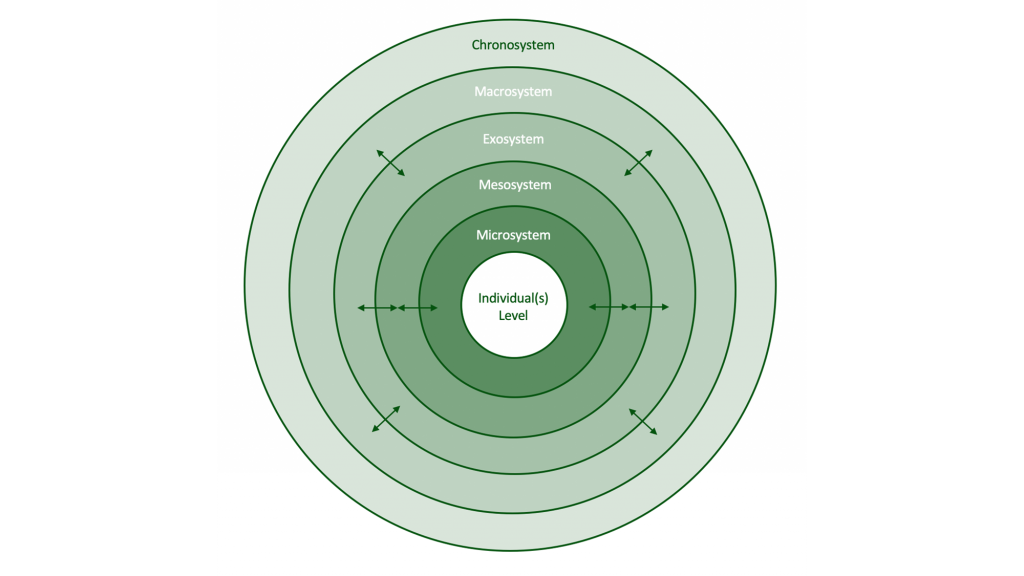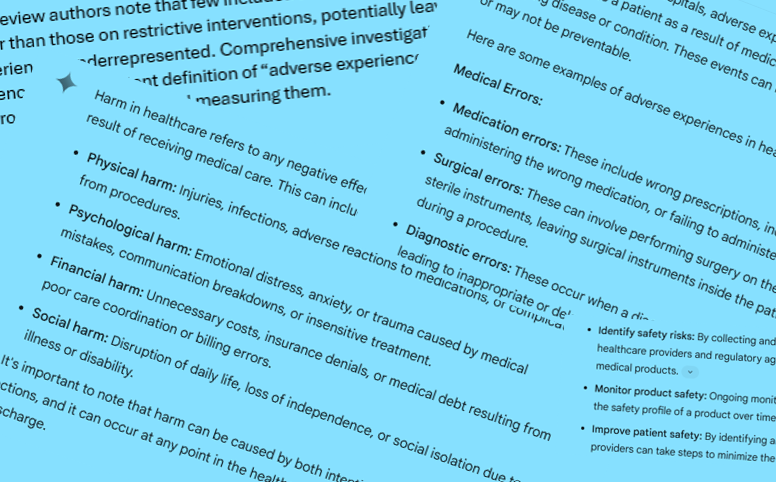[ad_1]
Inpatient psychological well being providers are supposed to present protected locations for individuals experiencing psychological well being difficulties to obtain help and get well, however for a lot of, the truth is much from this ultimate. Sufferers usually report distressing experiences, together with being subjected to restrictive practices like seclusion and restraint, coercion, and tedium. Removed from aiding restoration, these experiences can compound trauma and make restoration more difficult. These are subjects which have been coated extensively on the Psychological Elf and cross the age ranges together with children and young people’s inpatient services.
To enhance inpatient psychological well being care, it’s essential we absolutely perceive sufferers’ detrimental experiences in order that we will discover methods to handle them. Earlier critiques have examined particular elements of sufferers’ detrimental experiences, reminiscent of how they’re impacted by surveillance technologies on wards or other risk management practices. Some have additionally centered particularly on the experiences of marginalised teams, reminiscent of black service users, who face systemic racism in care.
Nevertheless, a current qualitative systematic evaluation by Hallett et al. (2024) is the primary to take a broader strategy, exploring the total vary of sufferers’ antagonistic experiences in inpatient psychological well being settings. It goes one step additional by making use of Bronfenbrenner’s ecological methods idea (1992) to the findings, a idea which explains how an individual’s experiences are formed by a number of layers of their surroundings, from their fast environment to wider societal elements.
By mapping how these layers affect antagonistic experiences in psychological well being wards, the evaluation affords precious insights that may information enhancements in service design and supply, in the end enhancing affected person care and outcomes.

This was the primary evaluation to discover the total vary of antagonistic inpatient experiences and the primary to use Bronfenbrenner’s ecological methods idea.
The researchers systematically reviewed qualitative research exploring sufferers’ antagonistic experiences in acute grownup, forensic, and psychiatric intensive psychological well being inpatient care. They excluded specialist settings, reminiscent of inpatient providers for kids and younger individuals, older adults, or individuals with studying disabilities.
They searched three tutorial databases and Google Scholar for related analysis. Information was extracted, checked, and research have been high quality assessed utilizing the Vital Appraisal Abilities Programme (CASP) guidelines.
The researchers used a “best-fit” framework to organise the qualitative findings within the included research. They began with themes primarily based on current data and refined them as new insights emerged throughout their evaluation.
The group included a researcher with lived expertise of inpatient psychological well being care who was concerned in all phases of the evaluation. The group additionally gathered suggestions on preliminary themes from a Affected person and Public Involvement group. This group, made up of 5 service customers with assorted experiences of acute and safe inpatient psychological well being care, helped form the evaluation’s findings, guaranteeing they mirrored the true experiences of sufferers.

The group included a researcher with lived expertise of inpatient psychological well being care and gathered suggestions on preliminary themes from a Affected person and Public Involvement group.
111 papers have been included within the evaluation. These papers used a variety of methodologies and have been general rated pretty much as good high quality. The research spanned the globe however have been predominantly performed in Europe (n = 80).
The evaluation discovered a variety of things associated to antagonistic inpatient experiences, suggesting that traumatic experiences in psychological well being inpatient settings can worsen outcomes. Hostile experiences have been described below three most important headings: the ecosystem, methods, and the person.
The ecosystem
‘The ecosystem’ was described because the bodily surroundings and obtainable sources through which antagonistic experiences happen, and different individuals inside or influential to that surroundings. Hostile experiences associated to the bodily surroundings and included elements reminiscent of poor ward situations (e.g., sensory overlap reminiscent of loud noises and alarms going off), lack of actions resulting in boredom, and emotions of wards being unsafe and like a jail as a consequence of blanket guidelines and observations. Components associated to interactions with others – normally ward employees, but in addition fellow sufferers and members of the family – additionally contributed to detrimental experiences. These included low employees numbers and the tradition of poor visibility of employees in communal areas, lack of knowledge, exclusion from decision-making about one’s personal care, and poor employees attitudes. These included stigmatisation and racism in the direction of sufferers.
Programs
‘Programs’ have been described because the formal processes of therapy together with coercive administration methods (e.g., seclusion, restraint, threats of involuntary detention), the usage of psychotropic remedy, and the monitoring of progress by way of ward rounds. Such processes have been felt to be punitive and induce worry amongst individuals and have been seen as intimidating and ineffective. Transitions (i.e. admission, switch and discharge) have been generally related to worry, whether or not they have been voluntary or involuntary, because of the perceived coercion related to these processes. This was significantly the case for admission processes involving police presence. For each admission and discharge transitions, poor communication and lack of involvement have been seen as contributing to detrimental experiences.
The person
‘The person’ was described because the infringements on autonomy and the (re)traumatisation that may be attributable to the totality of antagonistic experiences. Being on a ward usually led to sufferers feeling a lack of management, privateness, freedom, energy and selection, all of which created antagonistic experiences. These included lack of management or selection over admission or therapy selections, bodily obstacles reminiscent of locked doorways, the dearth of autonomy over on a regular basis actions reminiscent of mealtimes and bedtimes, restrictions over the usage of private gadgets, and the ability imbalance felt between sufferers and employees. Sufferers reported feeling coerced and infantilised, with false selections somewhat than autonomy. All through the literature, sufferers described feeling traumatised by their experiences on inpatient wards, with elements reminiscent of gender, abuse, and racism contributing to this.

The evaluation discovered a variety of things associated to antagonistic inpatient experiences, suggesting that traumatic experiences in inpatient settings can worsen outcomes.
Conclusions
This evaluation has proven that, on a worldwide scale, adversity in inpatient psychological well being settings extends far past the hurt brought on by restrictive interventions. It highlights the advanced interaction between systemic, environmental, and particular person elements that contribute to those detrimental experiences. The evaluation demonstrates that whereas the challenges are important, the alternatives for enhancing psychological well being inpatient care are substantial.
Strengths and limitations
This evaluation attracts on a various vary of research from a number of nations, specializing in antagonistic inpatient experiences – addressing a key hole within the literature. It offers a precious framework for mapping and addressing these detrimental experiences, providing sensible insights for a variety of stakeholders. The analysis benefitted from significant involvement of individuals with lived expertise all through the challenge, serving to to make sure that the findings are grounded in real-world views.
Nevertheless, there are some limitations to contemplate. A big proportion of the included research have been performed in Europe, and the authors solely included research printed in English. This will restrict how properly the findings apply to different psychological well being methods. Sure settings, reminiscent of inpatient providers for kids and younger individuals, people with studying disabilities, and older adults, have been excluded, proscribing the applicability of the findings to those teams.
Whereas ecological methods idea offered a precious and sensible framework for deciphering the findings of this evaluation, it has some limitations. The evaluation didn’t study intimately variations in findings throughout completely different settings and populations, reminiscent of nations, ward varieties, or affected person demographics. Consequently, while the framework offered is broadly relevant to inpatient psychological well being providers on the whole, it might not absolutely account for the distinctive nuances of particular contexts and populations. One other limitation of the framework is that the boundaries between system ranges can typically be unclear, and the relative affect of various layers could differ throughout cultural contexts and over time – elements that would have been explored additional within the paper.
The evaluation authors notice that few included research explicitly examined antagonistic experiences, aside from these on restrictive interventions, probably leaving sure elements of sufferers’ experiences underrepresented. Complete investigation is additional sophisticated by the absence of a constant definition of “antagonistic experiences” within the literature, and assorted approaches to finding out and measuring them.
Analysis findings are formed not solely by how antagonistic experiences are conceptualised, but in addition by examine designs, together with knowledge assortment and evaluation strategies. Lots of the included research lacked transparency relating to the character of interviewer-participant relationships, making it difficult for the reviewers to evaluate potential biases. And, whereas reviewers examined affected person quotes within the unique research to attempt to mitigate selective reporting, such biases could persist. These limitations could have meant that sufferers’ experiences weren’t absolutely or precisely represented, particularly given the dearth of affected person co-researchers in most research.
Lastly, the evaluation’s deal with antagonistic experiences is each a power, because it addresses an vital however under-explored space, and a limitation, as it might unintentionally overlook the complexity and variety of sufferers’ experiences in inpatient settings. Many individuals may need each detrimental and optimistic experiences, and what one individual finds dangerous might be useful for another person. A extra balanced strategy that considers each optimistic and detrimental experiences may present a extra full understanding of inpatient care. Capturing the total vary of affected person experiences would spotlight not simply what causes hurt, but in addition what helps restoration, additional guiding enhancements in inpatient.

Hostile experiences weren’t constantly outlined throughout included research and few of them explicitly examined antagonistic experiences.
Implications for apply
The framework developed from the findings of this evaluation affords a software for a variety of stakeholders, from lecturers and clinicians to commissioners and policymakers, to raised perceive and deal with antagonistic experiences in inpatient psychological well being settings. It highlights the interconnectedness of particular person, relational, and societal elements in inpatient care. By addressing the total spectrum of antagonistic experiences recognized, psychological well being providers could make strides in the direction of environments that not solely stop hurt however actively contribute to the wellbeing and restoration of people of their care.
The evaluation’s emphasis on the position of systemic elements in shaping sufferers’ experiences is vital as a result of it challenges the frequent however problematic concept that restoration is principally a matter of particular person resilience. This level is pushed dwelling when the authors ask:
How can somebody anticipate to get well, or at the very least enhance to the purpose of discharge, when they’re surrounded by an ecosystem, and the related processes and transitions, that create adversity.
Recognising the affect of those broader contexts shifts the main focus from anticipating people to easily cope higher, to addressing the structural adjustments to inpatient providers wanted to scale back hurt.
Significant change in inpatient psychological well being care is more likely to be advanced, requiring consideration of numerous elements and views. It’s potential that some antagonistic experiences are inevitable within the present system, particularly when sufferers’ rights are restricted, and there are in all probability no one-size-fits-all options. Nevertheless, the findings of this evaluation provide a precious start line for conversations between sufferers, carers, healthcare professionals, and policymakers to raised perceive how sufferers are impacted by inpatient care. These insights may help information actions to scale back hurt and enhance care in any respect ranges:
- on the particular person degree (e.g., by rising affected person selection, management, and freedom),
- inside methods (e.g. by decreasing coercive practices and enhancing admission/discharge procedures),
- in ecosystems (e.g. by enhancing bodily ward environments and rising affected person involvement), and
- in broader policymaking (e.g. by shaping nationwide insurance policies and finest apply pointers).
Collectively, this might make inpatient care extra inclusive, extra centred on affected person autonomy, and fewer traumatising; in the end decreasing hurt and enhancing care throughout the system.
This evaluation’s findings additionally spotlight the significance of involving individuals with lived expertise at each stage of future analysis – from growing analysis questions and designing research to gathering and analysing knowledge and sharing findings. Their involvement would assist guarantee analysis higher displays their priorities, views, and experiences. It might even be precious to work along with individuals who have skilled inpatient psychological well being care to create a extra inclusive and standardised definition of “antagonistic experiences.” This might assist future analysis take a extra constant and complete strategy to finding out these experiences and exploring change over time.
Future analysis may additionally discover how the framework offered on this paper could be tailor-made to completely different contexts, reminiscent of assorted ward varieties, geographic places, and affected person populations. Realist approaches might be used to additional examine the mechanisms underpinning the hyperlinks between these elements and outcomes – analyzing what works (or doesn’t), for whom, in what circumstances, and why, to tell the event of tailor-made interventions. This is able to assist stakeholders implement simpler, evidence-based methods to stop hurt and promote optimistic outcomes throughout numerous inpatient settings and populations.

By addressing the total spectrum of antagonistic experiences, psychological well being providers could make strides in the direction of environments that not solely stop hurt, however actively contribute to the wellbeing and restoration of people of their care.
Assertion of pursuits
None.
Hyperlinks
Major paper
Hallett, N., Dickinson, R., Eneje, E., & Dickens, G. L. (2024). Hostile psychological well being inpatient experiences: Qualitative systematic evaluation of worldwide literature. Worldwide journal of nursing research, 161, 104923. Advance on-line publication. https://doi.org/10.1016/j.ijnurstu.2024.104923
Different references
Astrid Moell, Maria Smitmanis Lyle, Alexander Rozental, Niklas Långström, 2024 Charges and threat elements of coercive measure use in inpatient youngster and adolescent psychological well being providers: a scientific evaluation and narrative synthesis, The Lancet Psychiatry, https://doi.org/10.1016/S2215-0366(24)00204-9.
Griffiths, J. L., Saunders, Okay. R. Okay., Foye, U., Greenburgh, A., Regan, C., Cooper, R. E., Powell, R., Thomas, E., Brennan, G., Rojas-García, A., Lloyd-Evans, B., Johnson, S., & Simpson, A. (2024). The use and affect of surveillance-based know-how initiatives in inpatient and acute psychological well being settings: a scientific evaluation. BMC drugs, 22(1), 564. https://doi.org/10.1186/s12916-024-03673-9
Bronfenbrenner, U. (2005). Ecological methods idea (1992). In U. Bronfenbrenner (Ed.), Making human beings human: Bioecological views on human growth (pp. 106–173). Sage Publications Ltd.
Deering, Kris, Chris Wagstaff, Jo Williams, Ivor Bermingham, and Chris Pawson. 2023. ‘Ontological Insecurity of Inattentiveness Conceptualizing How Threat Administration Influence on Affected person Restoration When Admitted to an Acute Psychiatric Hospital.’ Worldwide Journal of Psychological Well being Nursing Early View: 1–11. https://doi.org/10.1111/inm.13245
Solanki, J., Wooden, L., & McPherson, S. (2023). Experiences of adults from a Black ethnic background detained as inpatients under the Mental Health Act (1983). Psychiatric Rehabilitation Journal, 46(1), 14.
Verbeke E, Vanheule S, Cauwe J, Truijens F, Froyen B. (2019) Coercion and energy in psychiatry: A qualitative examine with ex-patients. Soc Sci Med. 2019 Feb;223:89-96. doi: 10.1016/j.socscimed.2019.01.031. Epub 2019 Jan 22. https://doi.org/10.1016/j.socscimed.2019.01.031
Photograph credit
[ad_2]
Source link

